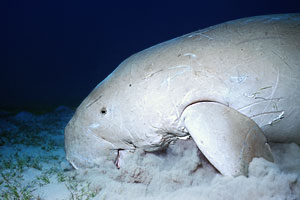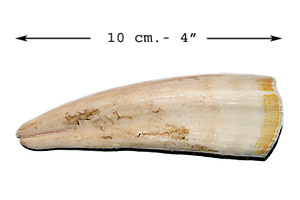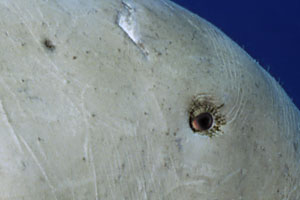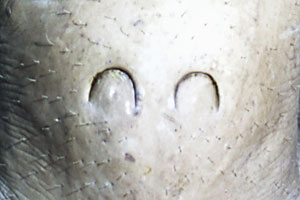|
|
| |
 
 |
A female is feeding
ignoring my presence |
| Kingdom: | Animalia |
| Phylum: | Chordata |
| Subphylum: | Vertebrata |
| Class: | Mammalia |
| Order: | Sirenia |
| Family: | Dugongidae |
| Genus: | Dugong |
| Species: | Dugong dugon |
The dugong (Dugong dugon) is the only strictly herbivorous marine mammal and is the
only extant species in the Family Dugongidae. It must not be confused with the better known manatee,
which belongs to the Family Trichechidae and can also live in fresh water.
The adults are 3 meters in length and weigh up to 400 Kg (someone reports 900 Kg). There is no sexual
dimorphism, but it seems that females may slightly outsize males.
The massive body ends with a large flat tail with two elongated flukes, similar to the whale tail.
Manatee's tail, on the contrary, has a paddle-like shape, with no flukes.
The head has a characteristic rounded shape, the neck is short and not visible, the fleshy snout is
turned downward to facilitate grazing on seagrass meadows. The upper lip is cleft and protrudes over the
small mouth. It's strong and helps to eradicate seagrass. The lower jaw and palate have rough horny plates,
used to better grasp seagrass and chew it.
| |
 
 |
| Details: a dugong's tusk from Indonesia |
Male specimens aged 12 or older have tusk-like incisors, while only few and very old females
have tusks. Adults have a total of 10-14 teeth. Molars are cylindrical, rootless and lack enamel.
The nose has no bone support, the skull is large in proportion to the size of the body, the zygomatic
arch is thick and deep.
The large nostrils, on the upper surface of the muzzle, are separated and have membranes, that act as
valves, in order to keep the water out while diving.
The body is protected by a thick layer of fat with a tough skin, smooth and wrinkled, with short sparse
hairs. These hairs are more concentrated on the lips and on the muzzle and help to find food, like
vibrissae (tactile hairs), while exploring the sandy bottom. Dugongs have, in fact, poor eyesight: the
eye is small, sunken and protected by a well developed nictitating membrane.
| |
 
 |
Details: dugong's small eye.
On top left, the tiny hear hole |
The fore-limbs have evolved in small flippers, no more than 50 cm long, with
well-developed skeletal support. They have a rounded shape and are located in an advanced position.
These flippers are used for propulsion by young specimens, whereas the adults use flippers only for steering and
for moving along the bottom while feeding. Adults use only the big tail for locomotion.
Dugongs are born with a light brown colour, which darkens as they grow older, dorsally and laterally, to a
more brown-yellowish colour.
The dugong's skeleton is dense and heavy, characterized by the absence of pneumatic cavities, thus
increasing the specific weight that helps to stay submerged in shallow waters.
Almost all information available on dugongs has been obtained by analysis of individuals trapped accidentally
and drowned in shark nets or killed by native hunters in northern Australia. The same methodology developed
for pinnipeds and cetaceans, based on the number of layers which compose their tusks, has been adopted to
estimate dugongs' age. The oldest dugong, of which tusks have been examined, was estimated to be
a female 73 years old.
Some studies show that females reach fertility at an age between 10 and 17 years, but a
recent research in the Torres Strait lowers this age to 6 years.
Gestation length is 13-15 months. Single calves are the norm and twins are rare. Newborns are about
100 cm long and weigh 30 kg. Parturition takes place in shallow water and the newborn swims
alone to the surface for its first breath.
The calf suckles for 14-18 months and grows quickly, because very soon he starts to eat seagrass too,
adding this food to the mother's milk. The period between one calving and another is variable and long,
estimated between 3 and 7 years.
| |
 
 |
| Details: dugong's nostrils |
Such a long period means that even in the most optimistic conditions, with low natural
mortality and no human-induced mortality, the maximum annual increase rate in population can't be higher
than 5%.
Unfortunately the human influence is becoming more and more invasive and in many areas there is no control,
because of wars or political troubles (like in Somalia).
Such a low growing rate, in these conditions, makes the dugong a species very vulnerable to extinction at
global scale. Conservation initiatives should be taken as soon as possible, with the agreement and cooperation
of all countries, to avoid the extinction of this old, beautiful animal.
NB: enlargements of all these photos are available in the Photo Gallery
[Home] | [Main
Index] | [Biology] | [Top]
|
|